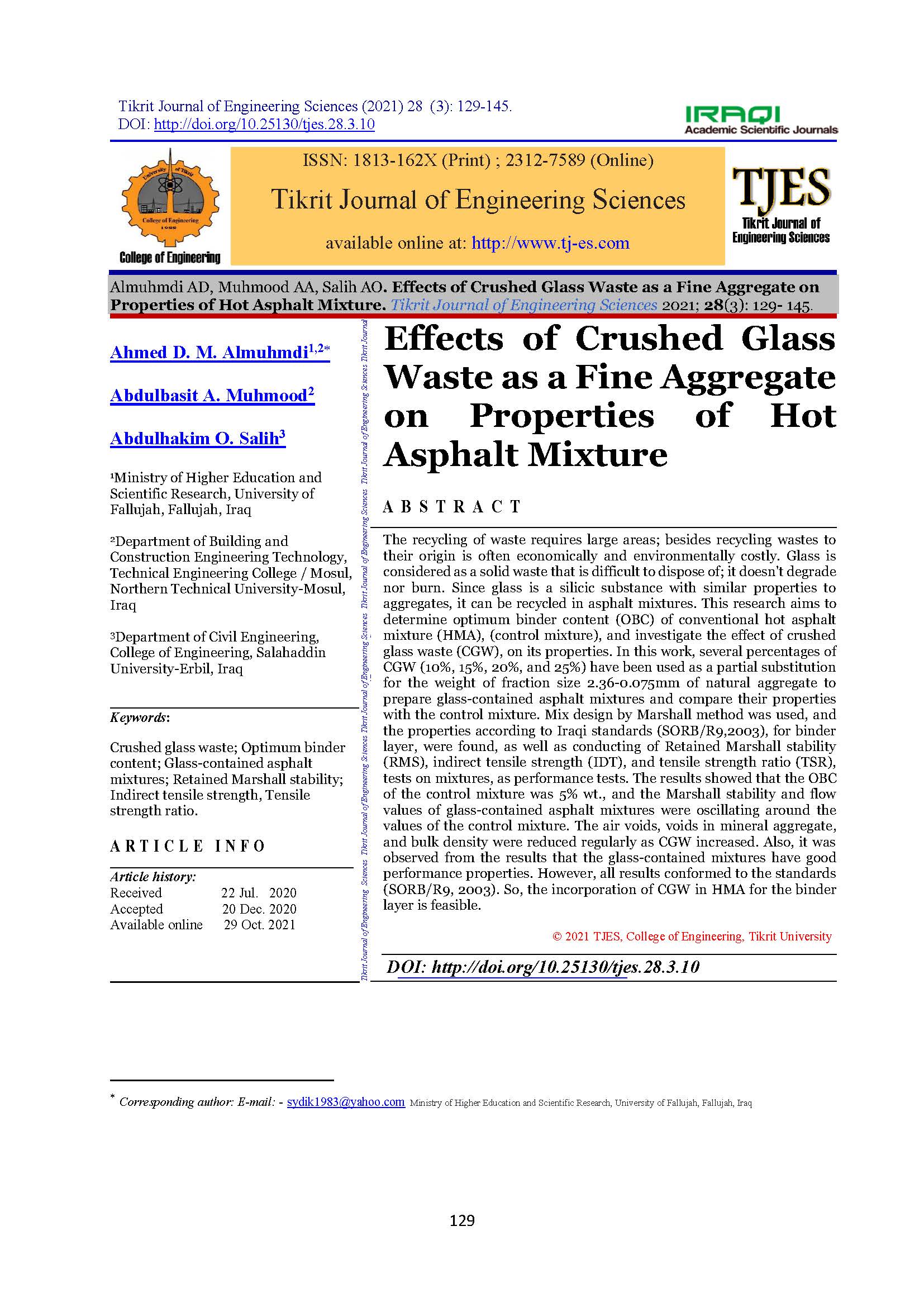Effects of Crushed Glass Waste as a Fine Aggregate on Properties of Hot Asphalt Mixture
Main Article Content
Abstract
The recycling of waste requires large areas; besides recycling wastes to their origin is often economically and environmentally costly. Glass is considered as a solid waste that is difficult to dispose of; it doesn't degrade nor burn. Since glass is a silicic substance with similar properties to aggregates, it can be recycled in asphalt mixtures. This research aims to determine optimum binder content (OBC) of conventional hot asphalt mixture (HMA), (control mixture), and investigate the effect of crushed glass waste (CGW), on its properties. In this work, several percentages of CGW (10%, 15%, 20%, and 25%) have been used as a partial substitution for the weight of fraction size 2.36-0.075mm of natural aggregate to prepare glass-contained asphalt mixtures and compare their properties with the control mixture. Mix design by Marshall method was used, and the properties according to Iraqi standards (SORB/R9,2003), for binder layer, were found, as well as conducting of Retained Marshall stability (RMS), indirect tensile strength (IDT), and tensile strength ratio (TSR), tests on mixtures, as performance tests. The results showed that the OBC of the control mixture was 5% wt., and the Marshall stability and flow values of glass-contained asphalt mixtures were oscillating around the values of the control mixture. The air voids, voids in mineral aggregate, and bulk density were reduced regularly as CGW increased. Also, it was observed from the results that the glass-contained mixtures have good performance properties. However, all results conformed to the standards (SORB/R9, 2003). So, the incorporation of CGW in HMA for the binder layer is feasible.
Metrics
Article Details

This work is licensed under a Creative Commons Attribution 4.0 International License.
THIS IS AN OPEN ACCESS ARTICLE UNDER THE CC BY LICENSE http://creativecommons.org/licenses/by/4.0/
Plaudit
References
Tahmoorian F, Samali B. Laboratory investigations on the utilization of RCA in asphalt mixtures. International Journal of Pavement Research and Technology 2018; 11 (6): 627-638.
Dalloul NK. Study of the Effect of Crushed Waste Glass as Coarse Sand and Filler in the Asphalt Binder Course. M.Sc. Thesis: Islamic University of Gaza; Gaza, Palestine: 2013.
Abukhettala M. Use of recycled materials in road construction. 2nd International Conference on Civil, Structural and Transportation Engineering (ICCSTE’16). 2016, May 5 - 6; Ottawa, Canada: University of Ottawa; pp. 1-8.
Huang Y, Bird NR, Heidrich O. A review of the use of recycled solid waste materials in asphalt pavements. Resources, conservation and recycling 2007; 52 (1): 58-73.
Fulton B, Fulton H. Use of recycled glass in pavement aggregate. The 23rd Australian Road Research Board International Conference. 2008, May; Adelaide, Australia; pp. 1-8
Al-Fakih A, Azan RM, Borisenko YG, Shvachev DP, Vorobyev DA, Amran YHM, Alyousef R, Alabduljabbar H. (2019). Bituminous mineral compositions for paving with cullet. Case Studies in Construction Materials 2020; 12: e00317.
Sadeghnejad M, Arabani M, Taghipoor M. Predicting the impact of temperature and stress on the glasphalt mixtures’ rutting behavior. International Journal of Pavement Research and Technology 2018; 11 (3): 300-310.
Anochie-Boateng J, George T. Use of waste crushed glass for the production of hot-mix asphalt. Sustainable Construction Materials and Technologies 2016.
Issa Y. Effect of adding crushed glass to asphalt mix. Archives of Civil Engineering 2016; 62 (2): 35 - 44.
Abusalem, ZT, Khadawi TS, Baker MB, Abendeh R. Effect of waste glass on properties of asphalt concrete mixtures. Jordan Journal of Civil Engineering 2017; 11 (1): 117 - 131.
Alhassan HM, Yunusa GH, Sanusl D. Potential of glass cullet as aggregate in hot mix asphalt. Nigerian Journal of Technology 2018; 37 (2): 338-345.
Al-saeedi BJK, Al-jameel HAE. Sustainable Performance of Iraqi Asphalt Base Course Using Recycled Glass as Aggregate Replacement. Journal of University of Babylon for Engineering Sciences 2018; 26 (5): 63-80.
Garber NJ, Hoel LA. Traffic & Highway Engineering-SI Version. 4th ed. Canada: Cengage Learning; 2009.
Ghasemi M, Marandi SM. Performance improvement of a crumb rubber modified bitumen using recycled glass powder. Journal of Zhejiang University SCIENCE A 2013; 14 (11): 805-814.
Sanij HK, Meybodi PA, Hormozaky MA, Hosseini SH, Olazar M. Evaluation of performance and moisture sensitivity of glass-containing warm mix asphalt modified with zycothermTM as an anti-stripping additive. Construction and Building Materials 2019; 197: 185-194.
Nikolaides A. Pavements, Materials and Control of Quality. New York: CRC press; 2014. [17] Hunter RN, Self A, Read J, Hobson E. (2015). The shell bitumen handbook. 6th ed. London: ICE Publishing; 2015.





